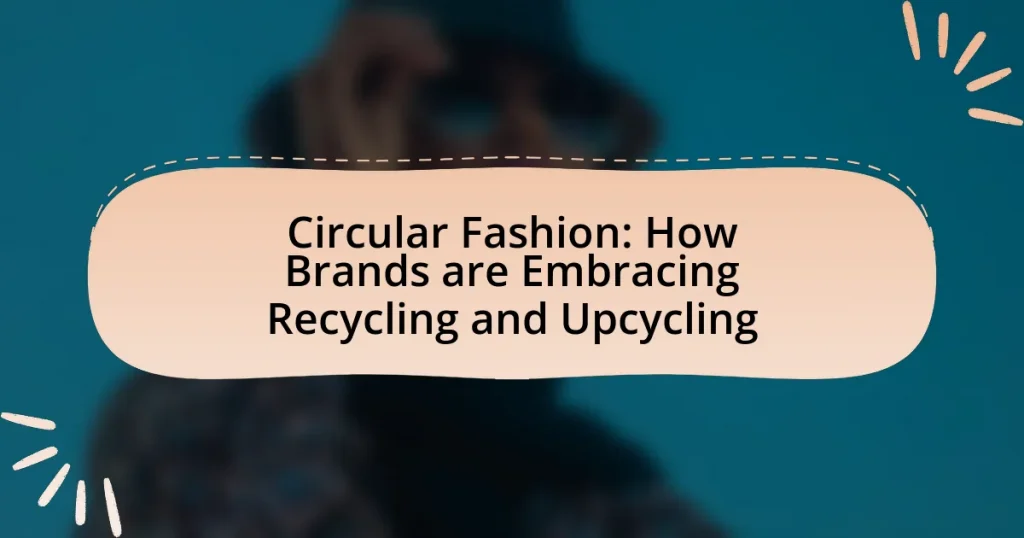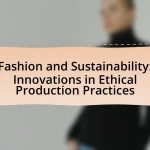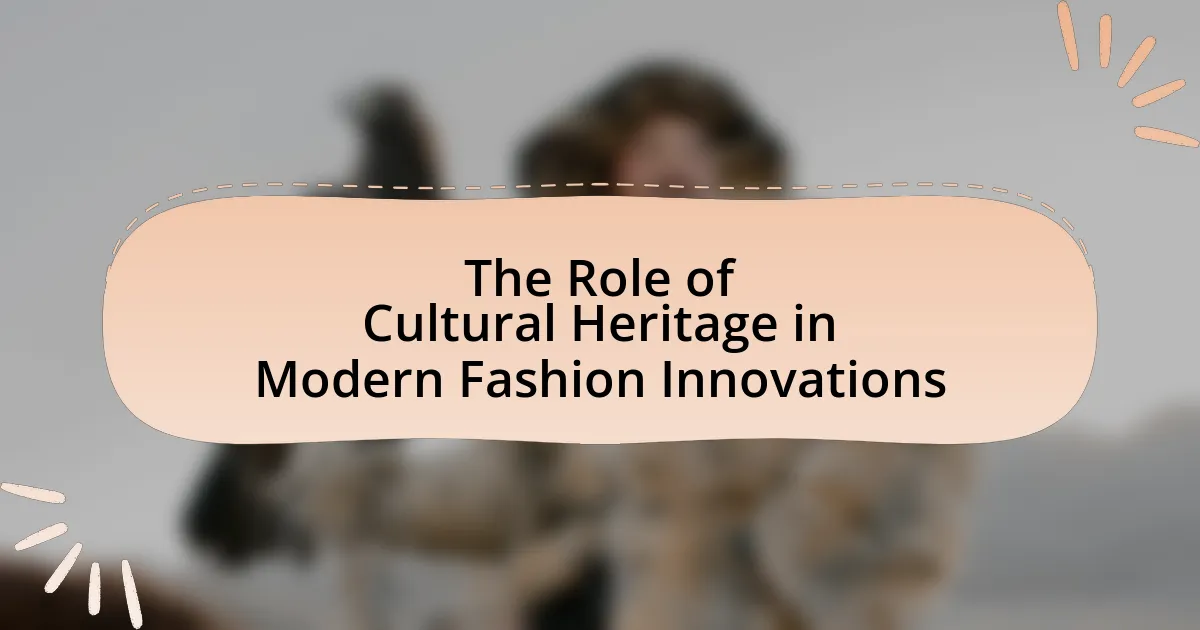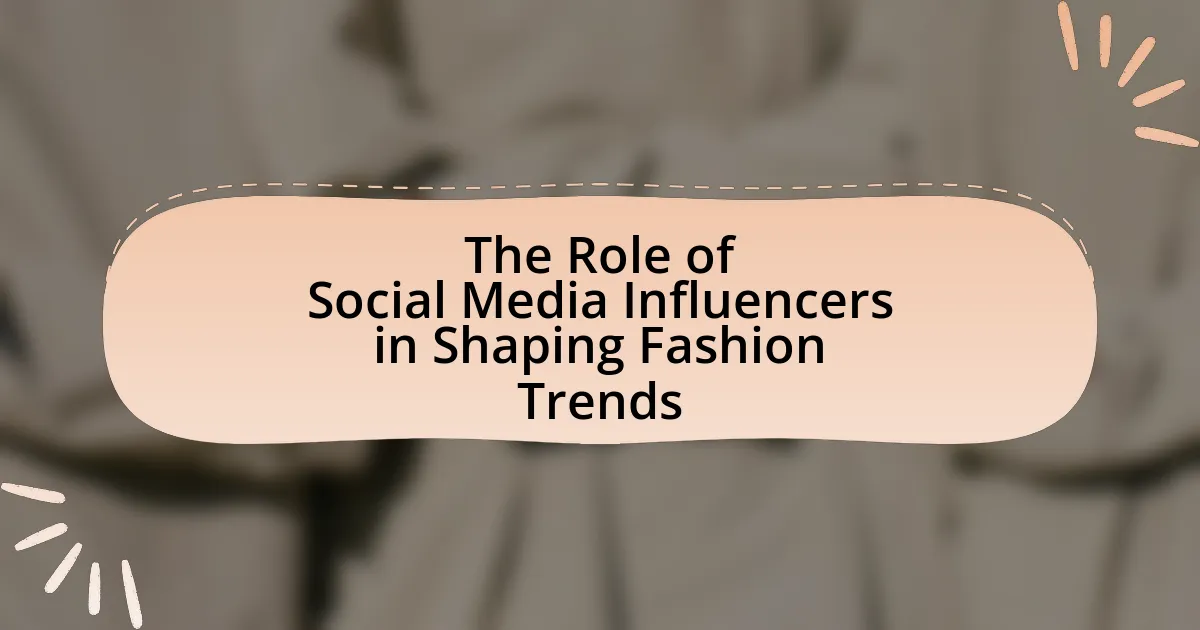Circular fashion is a sustainable approach to clothing and textile production that prioritizes the reuse, recycling, and upcycling of materials to minimize waste, contrasting with the traditional linear fashion model. This article explores how brands are adopting circular fashion principles, including designing for longevity, implementing recycling processes, and engaging in upcycling practices. Key topics include the environmental benefits of circular fashion, the role of technology and partnerships in facilitating these practices, and the challenges brands face in transitioning to a circular economy. Additionally, the article highlights consumer actions that support circular fashion and identifies brands committed to sustainable practices.
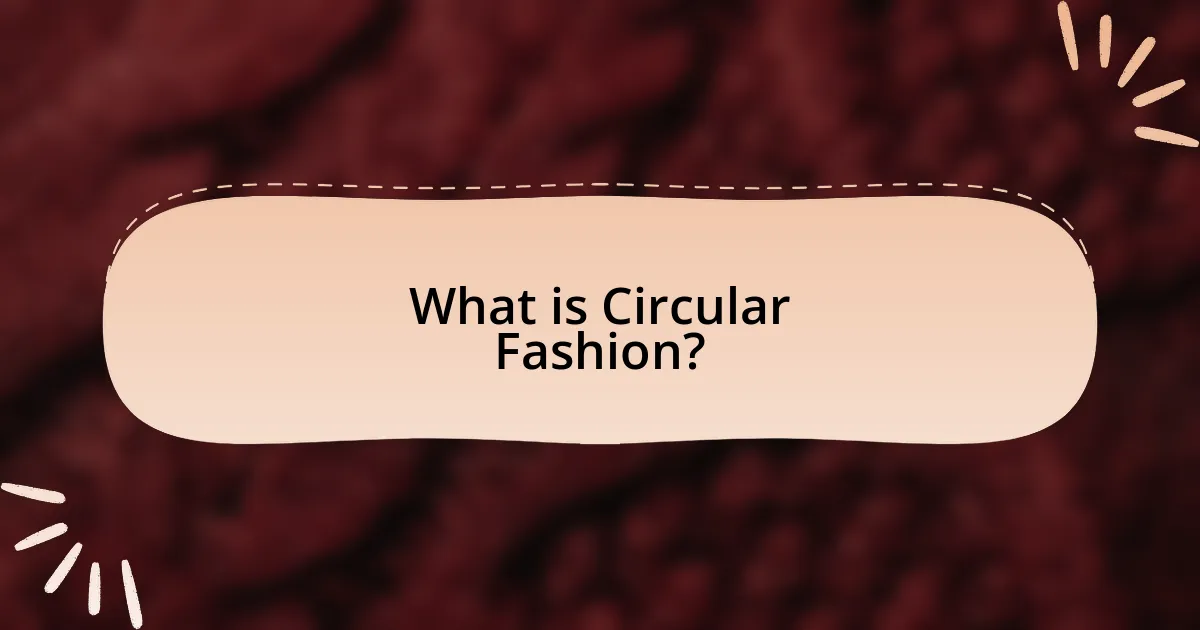
What is Circular Fashion?
Circular fashion is a sustainable approach to clothing and textile production that emphasizes the reuse, recycling, and upcycling of materials to minimize waste. This model contrasts with the traditional linear fashion system, which follows a “take-make-dispose” pattern. By focusing on extending the lifecycle of garments and utilizing resources efficiently, circular fashion aims to reduce environmental impact and promote a more sustainable economy. According to the Ellen MacArthur Foundation, transitioning to a circular economy in fashion could reduce greenhouse gas emissions by 44% by 2030, highlighting the significant potential benefits of this approach.
How does Circular Fashion differ from traditional fashion models?
Circular Fashion differs from traditional fashion models by prioritizing sustainability and resource efficiency throughout the product lifecycle. While traditional fashion often follows a linear model of “take, make, dispose,” Circular Fashion emphasizes reducing waste through practices like recycling, upcycling, and designing for longevity. For instance, a report by the Ellen MacArthur Foundation highlights that transitioning to a circular economy in fashion could reduce greenhouse gas emissions by 44% by 2030, demonstrating the significant environmental benefits of this approach compared to conventional practices.
What are the key principles of Circular Fashion?
The key principles of Circular Fashion include designing for longevity, promoting resource efficiency, and encouraging recycling and upcycling. Designing for longevity ensures that products are made to last, reducing the need for frequent replacements. Resource efficiency focuses on minimizing waste and utilizing sustainable materials throughout the production process. Recycling and upcycling involve repurposing materials from discarded products to create new items, thereby closing the loop in the fashion lifecycle. These principles collectively aim to reduce environmental impact and promote sustainable consumption in the fashion industry.
Why is Circular Fashion important for sustainability?
Circular fashion is important for sustainability because it minimizes waste and promotes the continual use of resources. By designing products for longevity, repairability, and recyclability, circular fashion reduces the environmental impact associated with traditional linear models, where items are produced, used, and discarded. According to the Ellen MacArthur Foundation, transitioning to a circular economy could reduce global carbon emissions by 39% by 2030, highlighting its potential to significantly mitigate climate change.
What role do recycling and upcycling play in Circular Fashion?
Recycling and upcycling are essential components of Circular Fashion as they help reduce waste and extend the lifecycle of materials. Recycling transforms discarded textiles into new fibers or products, minimizing the need for virgin resources and decreasing environmental impact. Upcycling, on the other hand, creatively repurposes old garments into new, higher-value items, promoting innovation and reducing landfill contributions. According to the Ellen MacArthur Foundation, implementing circular practices, including recycling and upcycling, can significantly lower the fashion industry’s carbon footprint, which is projected to reach 1.5 billion tons of greenhouse gas emissions by 2030 if current trends continue.
How are recycling processes integrated into fashion brands?
Recycling processes are integrated into fashion brands through the implementation of closed-loop systems that allow for the reuse of materials in new products. Brands like H&M and Patagonia have established take-back programs where customers can return used garments, which are then sorted, recycled, or upcycled into new clothing. For instance, H&M’s Conscious Collection incorporates recycled polyester made from plastic bottles, demonstrating a tangible commitment to sustainability. Additionally, brands often collaborate with recycling facilities to ensure that textile waste is processed efficiently, further embedding recycling into their operational models.
What are the benefits of upcycling in the fashion industry?
Upcycling in the fashion industry offers significant benefits, including reduced waste, resource conservation, and enhanced creativity. By transforming discarded materials into new products, upcycling minimizes landfill contributions, addressing the fashion industry’s substantial waste problem, which is estimated to be 92 million tons annually. Additionally, upcycling conserves resources by decreasing the demand for new raw materials, thereby lowering environmental impact. This practice also fosters innovation, as designers explore unique ways to repurpose materials, leading to distinctive and often one-of-a-kind fashion items.
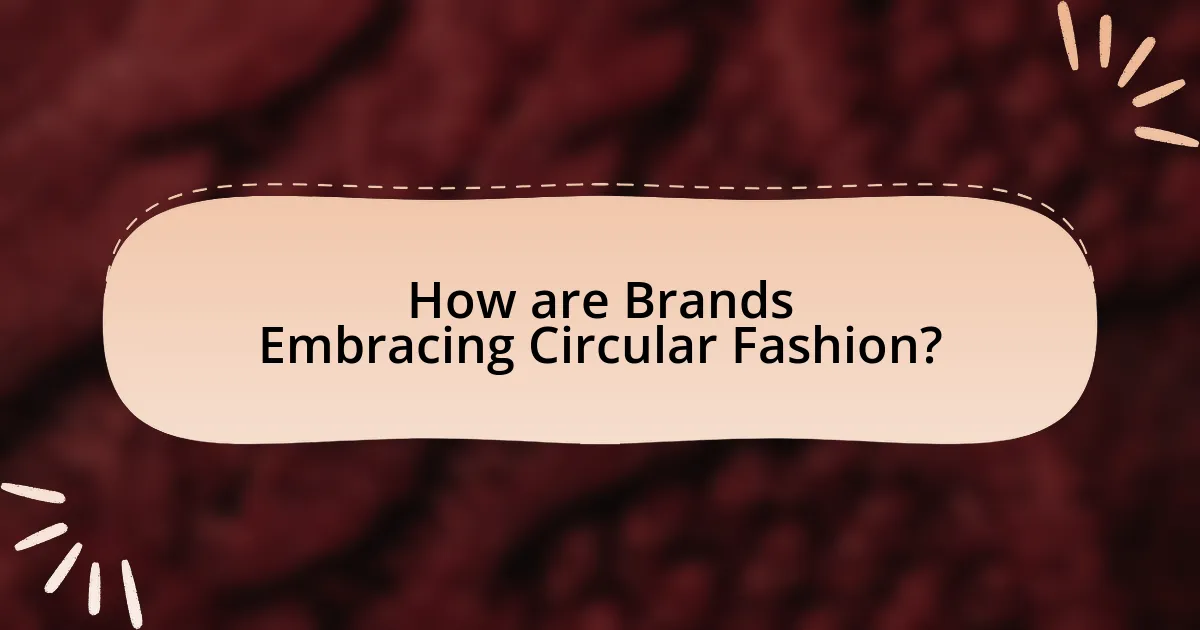
How are Brands Embracing Circular Fashion?
Brands are embracing circular fashion by implementing sustainable practices such as recycling, upcycling, and designing for longevity. For instance, companies like Patagonia and H&M have introduced take-back programs that encourage customers to return used garments for recycling or resale, thereby reducing waste. Additionally, brands are increasingly using recycled materials in their products; for example, Adidas has launched shoes made from ocean plastic, demonstrating a commitment to reducing environmental impact. These initiatives not only promote sustainability but also align with consumer demand for eco-friendly products, as evidenced by a 2021 McKinsey report indicating that 67% of consumers consider sustainability when making a purchase.
What strategies are brands using to implement Circular Fashion?
Brands are implementing Circular Fashion through strategies such as designing for longevity, utilizing recycled materials, and establishing take-back programs. By focusing on durable designs, brands like Patagonia ensure products last longer, reducing waste. The use of recycled materials is exemplified by companies like Adidas, which incorporates ocean plastic into its footwear, thereby minimizing resource extraction. Additionally, take-back programs, such as those offered by H&M, encourage consumers to return used garments for recycling or resale, promoting a closed-loop system. These strategies collectively contribute to reducing environmental impact and fostering sustainable consumption practices.
How do brands source materials for recycling and upcycling?
Brands source materials for recycling and upcycling primarily through partnerships with waste management companies, textile recyclers, and consumer take-back programs. These collaborations enable brands to collect post-consumer waste, such as discarded clothing and textiles, which can be repurposed into new products. For instance, companies like H&M and Patagonia have established take-back initiatives that encourage customers to return used garments, thereby increasing the availability of raw materials for recycling. Additionally, some brands engage in sourcing surplus materials from manufacturers, which helps reduce waste in the production process. This approach not only supports sustainability efforts but also aligns with the growing consumer demand for eco-friendly practices in the fashion industry.
What partnerships are essential for brands to succeed in Circular Fashion?
Essential partnerships for brands to succeed in Circular Fashion include collaborations with recycling facilities, sustainable material suppliers, and technology innovators. Recycling facilities enable brands to effectively process and repurpose materials, while sustainable material suppliers provide eco-friendly alternatives that align with circular principles. Technology innovators contribute solutions for tracking product lifecycle and enhancing recycling processes. For instance, brands like Patagonia partner with recycling companies to reclaim worn-out garments, demonstrating the effectiveness of such collaborations in reducing waste and promoting sustainability.
What challenges do brands face in adopting Circular Fashion?
Brands face several challenges in adopting Circular Fashion, primarily including supply chain complexities, consumer perception, and economic viability. Supply chain complexities arise from the need to establish new processes for recycling and upcycling materials, which can disrupt existing operations. Consumer perception poses a challenge as many consumers may not fully understand or value circular practices, leading to lower demand for circular products. Economic viability is also a significant hurdle, as the initial investment in sustainable practices can be high, and brands may struggle to balance costs with profitability. According to a report by McKinsey & Company, the transition to circular fashion could require an investment of up to $1 trillion in the next decade, highlighting the financial challenges brands face in this shift.
How can brands overcome barriers to implementing recycling practices?
Brands can overcome barriers to implementing recycling practices by investing in education and infrastructure that supports sustainable initiatives. By providing training for employees and consumers on the importance of recycling, brands can foster a culture of sustainability. Additionally, establishing partnerships with recycling facilities and organizations can streamline the recycling process, making it more accessible. For instance, companies like H&M have successfully implemented take-back programs, allowing customers to return used garments for recycling, which not only reduces waste but also encourages consumer participation in sustainable practices. This approach demonstrates that with the right resources and community engagement, brands can effectively navigate and dismantle the obstacles to recycling.
What are the common misconceptions about Circular Fashion?
Common misconceptions about Circular Fashion include the belief that it is solely about recycling, that it is only applicable to certain brands, and that it is not economically viable. Circular Fashion encompasses a broader approach that includes designing for longevity, repairability, and upcycling, not just recycling. Additionally, it is relevant to all brands, regardless of size or market segment, as many companies are adopting circular principles. Furthermore, studies indicate that Circular Fashion can lead to cost savings and new revenue streams, demonstrating its economic viability.
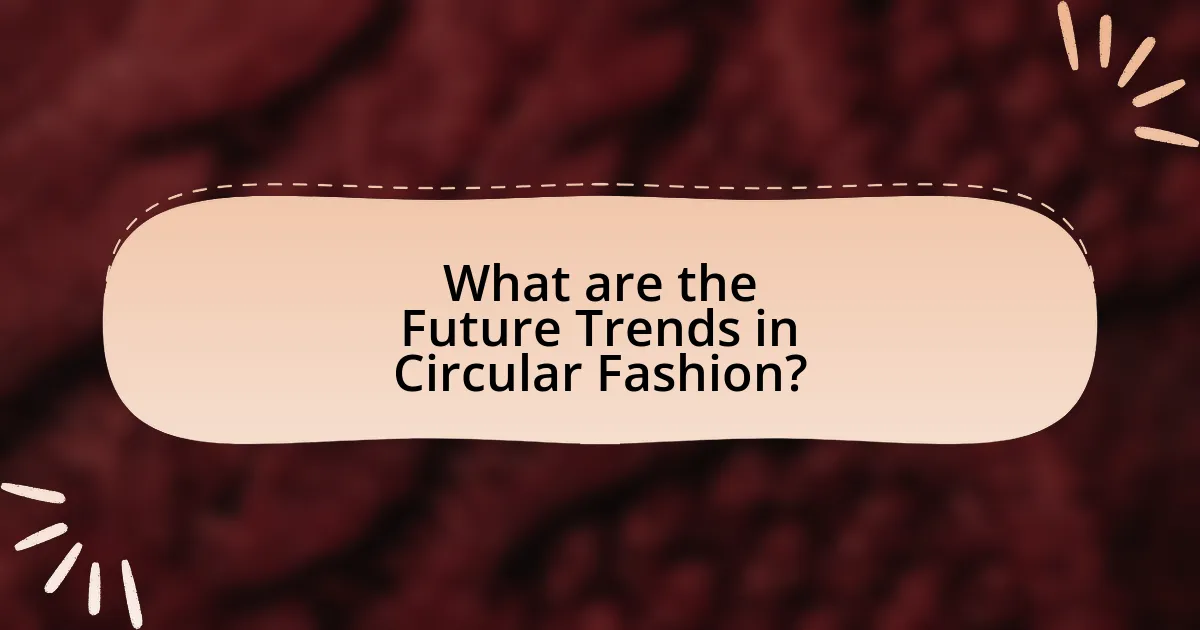
What are the Future Trends in Circular Fashion?
Future trends in circular fashion include increased adoption of sustainable materials, enhanced recycling technologies, and a shift towards rental and resale models. Brands are increasingly using biodegradable and recycled fabrics, which reduces waste and resource consumption. Advanced recycling technologies, such as chemical recycling, are being developed to reclaim materials from discarded garments, allowing for higher quality recycling. Additionally, the rise of platforms for renting and reselling clothing is promoting a circular economy by extending the lifecycle of garments. According to a report by McKinsey & Company, the global secondhand market is projected to reach $64 billion by 2024, highlighting the growing consumer interest in sustainable fashion practices.
How is technology influencing Circular Fashion?
Technology is significantly influencing Circular Fashion by enabling efficient recycling processes and enhancing supply chain transparency. Innovations such as blockchain technology allow brands to track the lifecycle of materials, ensuring that products are sourced sustainably and can be recycled effectively. For instance, companies like H&M and Adidas utilize digital platforms to monitor their materials, which facilitates the recycling of textiles and reduces waste. Additionally, advancements in fabric recycling technologies, such as chemical recycling, allow for the transformation of discarded garments into new fibers, thereby promoting a circular economy in the fashion industry.
What innovations are emerging in recycling and upcycling processes?
Innovations in recycling and upcycling processes include advanced sorting technologies, chemical recycling methods, and the use of artificial intelligence for material recovery. Advanced sorting technologies, such as near-infrared spectroscopy, enable more efficient separation of materials, increasing the purity of recycled outputs. Chemical recycling methods allow for the breakdown of plastics into their original monomers, facilitating the creation of new high-quality materials. Additionally, artificial intelligence enhances the efficiency of recycling facilities by optimizing sorting processes and predicting material flows, leading to higher recovery rates. These innovations are supported by industry reports indicating that improved recycling technologies can significantly reduce waste and enhance resource recovery in the circular economy.
How can data analytics improve Circular Fashion practices?
Data analytics can significantly enhance Circular Fashion practices by providing insights into consumer behavior, supply chain efficiency, and material lifecycle management. By analyzing data on consumer preferences and purchasing patterns, brands can better tailor their offerings to meet demand for sustainable products, thereby reducing waste. Additionally, data analytics can optimize supply chain operations by identifying inefficiencies and enabling better resource allocation, which is crucial for recycling and upcycling initiatives. For instance, a study by McKinsey & Company found that companies leveraging data analytics in their supply chains can reduce costs by up to 20%, which can be redirected towards sustainable practices. Furthermore, tracking the lifecycle of materials through data analytics allows brands to understand the environmental impact of their products, facilitating more informed decisions about recycling and upcycling processes.
What can consumers do to support Circular Fashion?
Consumers can support Circular Fashion by choosing to buy second-hand clothing and participating in clothing swaps. This practice reduces waste and extends the lifecycle of garments, which is essential for a circular economy. According to a report by the Ellen MacArthur Foundation, extending the life of clothes by just nine months can reduce carbon, water, and waste footprints by around 20-30%. Additionally, consumers can support brands that prioritize sustainable practices, such as using recycled materials and offering take-back programs for old clothing, further promoting the principles of Circular Fashion.
How can consumers identify brands that prioritize Circular Fashion?
Consumers can identify brands that prioritize Circular Fashion by looking for specific certifications, transparency in supply chains, and sustainable practices. Brands often display certifications such as the Global Organic Textile Standard (GOTS) or the Cradle to Cradle certification, which indicate adherence to sustainable and circular principles. Additionally, brands that openly share their sourcing, production processes, and recycling initiatives demonstrate a commitment to circularity. For instance, companies like Patagonia and Eileen Fisher are known for their take-back programs and use of recycled materials, showcasing their dedication to reducing waste and promoting sustainability.
What are practical tips for consumers to engage in recycling and upcycling?
Consumers can engage in recycling and upcycling by following specific practical tips. First, they should familiarize themselves with local recycling guidelines to ensure proper sorting of materials, as incorrect disposal can lead to contamination and increased landfill waste. Second, consumers can repurpose items creatively, such as turning old clothing into bags or using glass jars for storage, which reduces waste and encourages creativity. Third, participating in community swap events allows consumers to exchange items they no longer need, promoting reuse and reducing the demand for new products. Additionally, consumers can support brands that prioritize sustainable practices, as this encourages more companies to adopt recycling and upcycling methods. According to the Environmental Protection Agency, recycling and composting prevented the release of approximately 186 million metric tons of carbon dioxide equivalent into the air in 2018, highlighting the positive environmental impact of these actions.
